Liberty University: Transactional Leadership Annotated Bib
VerifiedAdded on 2022/08/12
|19
|5313
|12
Annotated Bibliography
AI Summary
This annotated bibliography provides a compilation of 20 works related to leading in a cultural context, specifically focusing on transactional leadership in a cross-cultural environment. The paper aims to assess the credibility of transactional leadership in diverse workplaces and its effectiveness in motivating employees. The bibliography includes at least five books and five journal or magazine articles, with no more than three websites. Each source is accompanied by a 150–200-word description explaining its general content and anticipated contribution to the research. The bibliography begins with an introductory paragraph outlining the intended focus of the paper and a thesis statement centered on transactional leadership in cross-cultural settings. Research questions address the traits of transactional leadership, its benefits in diverse workplaces, and its overall effectiveness in cross-cultural contexts. The objective is to understand how to maintain a diverse workplace and grasp the traits of transactional leadership, enhancing the understanding of its effectiveness.
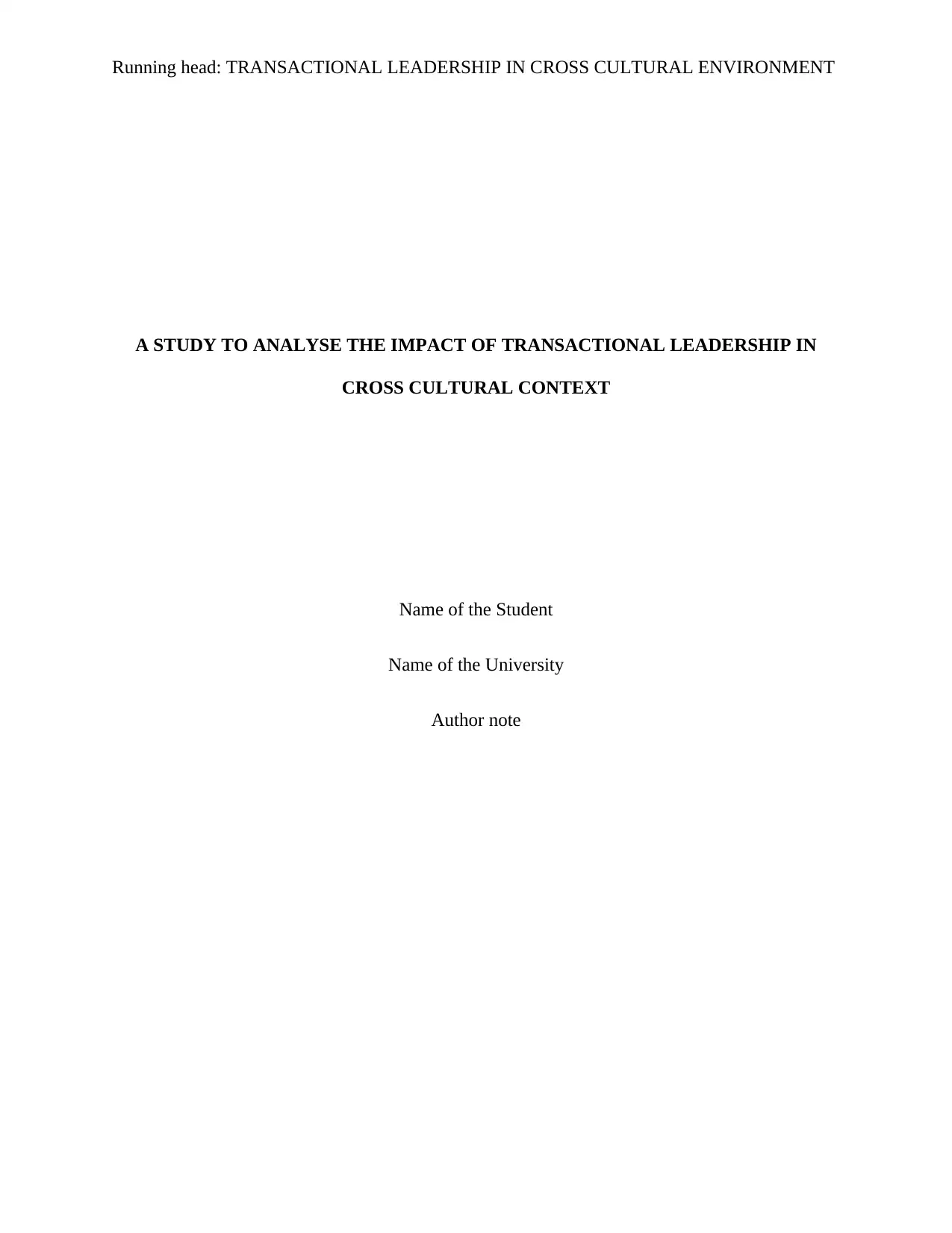
Running head: TRANSACTIONAL LEADERSHIP IN CROSS CULTURAL ENVIRONMENT
A STUDY TO ANALYSE THE IMPACT OF TRANSACTIONAL LEADERSHIP IN
CROSS CULTURAL CONTEXT
Name of the Student
Name of the University
Author note
A STUDY TO ANALYSE THE IMPACT OF TRANSACTIONAL LEADERSHIP IN
CROSS CULTURAL CONTEXT
Name of the Student
Name of the University
Author note
Paraphrase This Document
Need a fresh take? Get an instant paraphrase of this document with our AI Paraphraser
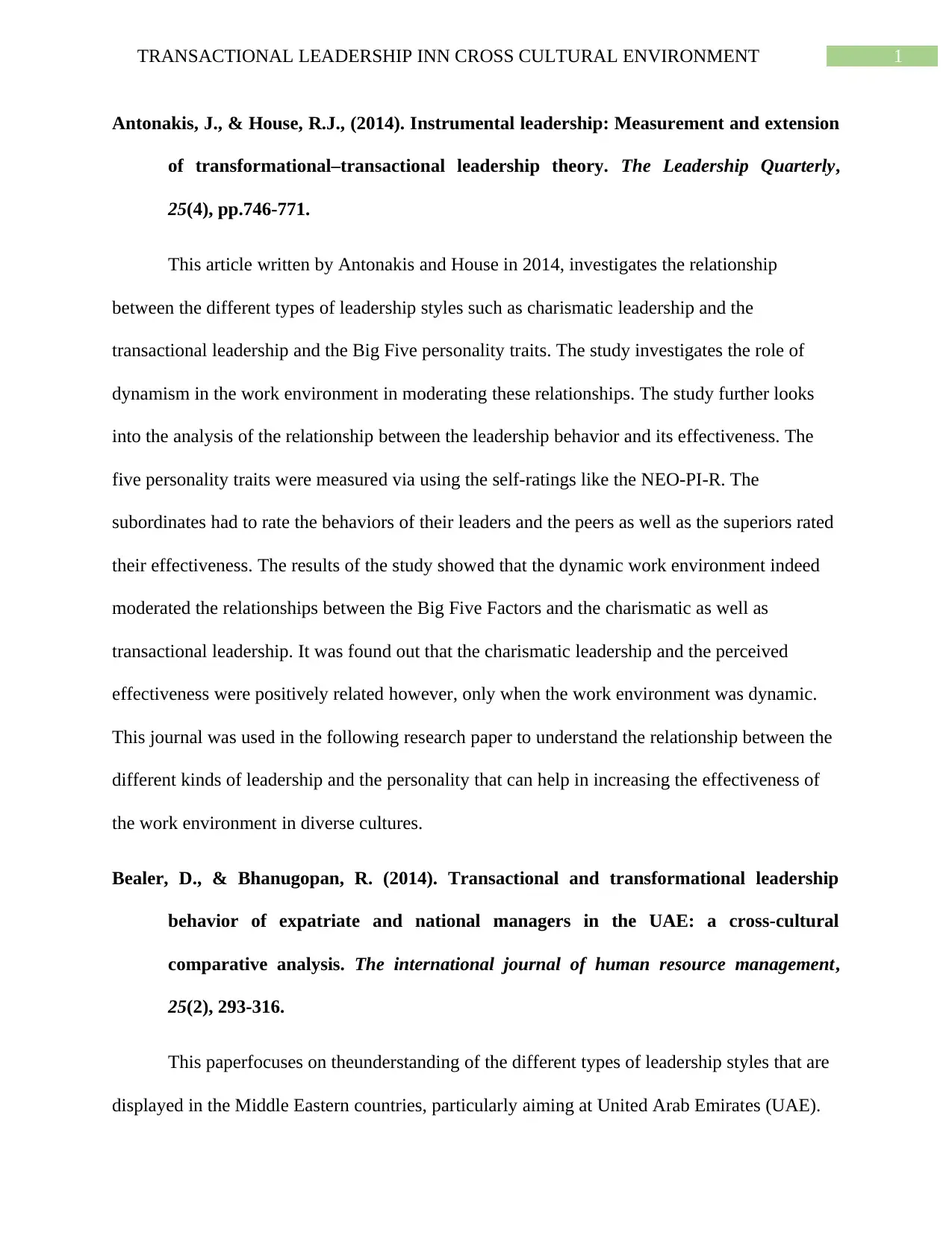
1TRANSACTIONAL LEADERSHIP INN CROSS CULTURAL ENVIRONMENT
Antonakis, J., & House, R.J., (2014). Instrumental leadership: Measurement and extension
of transformational–transactional leadership theory. The Leadership Quarterly,
25(4), pp.746-771.
This article written by Antonakis and House in 2014, investigates the relationship
between the different types of leadership styles such as charismatic leadership and the
transactional leadership and the Big Five personality traits. The study investigates the role of
dynamism in the work environment in moderating these relationships. The study further looks
into the analysis of the relationship between the leadership behavior and its effectiveness. The
five personality traits were measured via using the self-ratings like the NEO-PI-R. The
subordinates had to rate the behaviors of their leaders and the peers as well as the superiors rated
their effectiveness. The results of the study showed that the dynamic work environment indeed
moderated the relationships between the Big Five Factors and the charismatic as well as
transactional leadership. It was found out that the charismatic leadership and the perceived
effectiveness were positively related however, only when the work environment was dynamic.
This journal was used in the following research paper to understand the relationship between the
different kinds of leadership and the personality that can help in increasing the effectiveness of
the work environment in diverse cultures.
Bealer, D., & Bhanugopan, R. (2014). Transactional and transformational leadership
behavior of expatriate and national managers in the UAE: a cross-cultural
comparative analysis. The international journal of human resource management,
25(2), 293-316.
This paperfocuses on theunderstanding of the different types of leadership styles that are
displayed in the Middle Eastern countries, particularly aiming at United Arab Emirates (UAE).
Antonakis, J., & House, R.J., (2014). Instrumental leadership: Measurement and extension
of transformational–transactional leadership theory. The Leadership Quarterly,
25(4), pp.746-771.
This article written by Antonakis and House in 2014, investigates the relationship
between the different types of leadership styles such as charismatic leadership and the
transactional leadership and the Big Five personality traits. The study investigates the role of
dynamism in the work environment in moderating these relationships. The study further looks
into the analysis of the relationship between the leadership behavior and its effectiveness. The
five personality traits were measured via using the self-ratings like the NEO-PI-R. The
subordinates had to rate the behaviors of their leaders and the peers as well as the superiors rated
their effectiveness. The results of the study showed that the dynamic work environment indeed
moderated the relationships between the Big Five Factors and the charismatic as well as
transactional leadership. It was found out that the charismatic leadership and the perceived
effectiveness were positively related however, only when the work environment was dynamic.
This journal was used in the following research paper to understand the relationship between the
different kinds of leadership and the personality that can help in increasing the effectiveness of
the work environment in diverse cultures.
Bealer, D., & Bhanugopan, R. (2014). Transactional and transformational leadership
behavior of expatriate and national managers in the UAE: a cross-cultural
comparative analysis. The international journal of human resource management,
25(2), 293-316.
This paperfocuses on theunderstanding of the different types of leadership styles that are
displayed in the Middle Eastern countries, particularly aiming at United Arab Emirates (UAE).
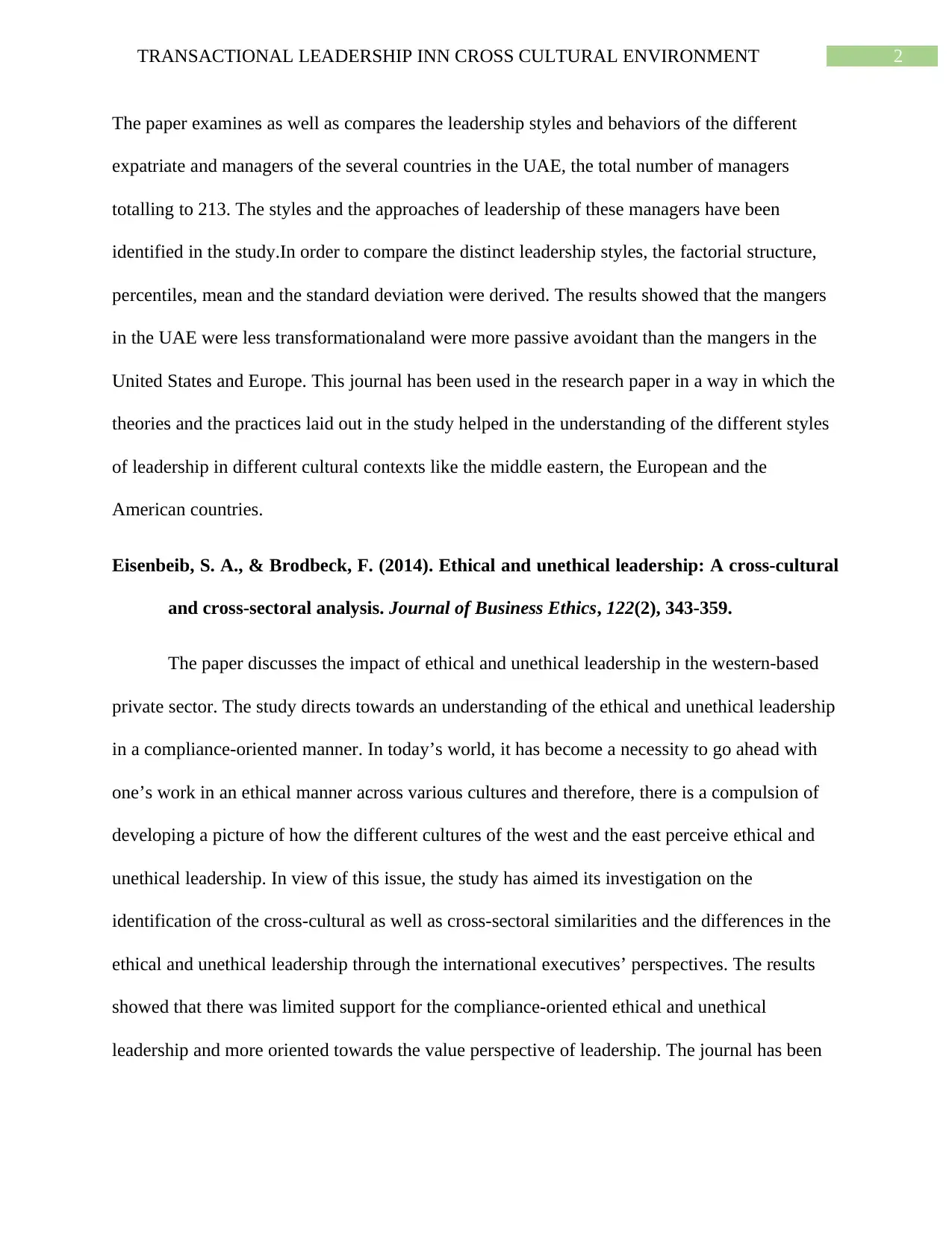
2TRANSACTIONAL LEADERSHIP INN CROSS CULTURAL ENVIRONMENT
The paper examines as well as compares the leadership styles and behaviors of the different
expatriate and managers of the several countries in the UAE, the total number of managers
totalling to 213. The styles and the approaches of leadership of these managers have been
identified in the study.In order to compare the distinct leadership styles, the factorial structure,
percentiles, mean and the standard deviation were derived. The results showed that the mangers
in the UAE were less transformationaland were more passive avoidant than the mangers in the
United States and Europe. This journal has been used in the research paper in a way in which the
theories and the practices laid out in the study helped in the understanding of the different styles
of leadership in different cultural contexts like the middle eastern, the European and the
American countries.
Eisenbeib, S. A., & Brodbeck, F. (2014). Ethical and unethical leadership: A cross-cultural
and cross-sectoral analysis. Journal of Business Ethics, 122(2), 343-359.
The paper discusses the impact of ethical and unethical leadership in the western-based
private sector. The study directs towards an understanding of the ethical and unethical leadership
in a compliance-oriented manner. In today’s world, it has become a necessity to go ahead with
one’s work in an ethical manner across various cultures and therefore, there is a compulsion of
developing a picture of how the different cultures of the west and the east perceive ethical and
unethical leadership. In view of this issue, the study has aimed its investigation on the
identification of the cross-cultural as well as cross-sectoral similarities and the differences in the
ethical and unethical leadership through the international executives’ perspectives. The results
showed that there was limited support for the compliance-oriented ethical and unethical
leadership and more oriented towards the value perspective of leadership. The journal has been
The paper examines as well as compares the leadership styles and behaviors of the different
expatriate and managers of the several countries in the UAE, the total number of managers
totalling to 213. The styles and the approaches of leadership of these managers have been
identified in the study.In order to compare the distinct leadership styles, the factorial structure,
percentiles, mean and the standard deviation were derived. The results showed that the mangers
in the UAE were less transformationaland were more passive avoidant than the mangers in the
United States and Europe. This journal has been used in the research paper in a way in which the
theories and the practices laid out in the study helped in the understanding of the different styles
of leadership in different cultural contexts like the middle eastern, the European and the
American countries.
Eisenbeib, S. A., & Brodbeck, F. (2014). Ethical and unethical leadership: A cross-cultural
and cross-sectoral analysis. Journal of Business Ethics, 122(2), 343-359.
The paper discusses the impact of ethical and unethical leadership in the western-based
private sector. The study directs towards an understanding of the ethical and unethical leadership
in a compliance-oriented manner. In today’s world, it has become a necessity to go ahead with
one’s work in an ethical manner across various cultures and therefore, there is a compulsion of
developing a picture of how the different cultures of the west and the east perceive ethical and
unethical leadership. In view of this issue, the study has aimed its investigation on the
identification of the cross-cultural as well as cross-sectoral similarities and the differences in the
ethical and unethical leadership through the international executives’ perspectives. The results
showed that there was limited support for the compliance-oriented ethical and unethical
leadership and more oriented towards the value perspective of leadership. The journal has been
⊘ This is a preview!⊘
Do you want full access?
Subscribe today to unlock all pages.

Trusted by 1+ million students worldwide
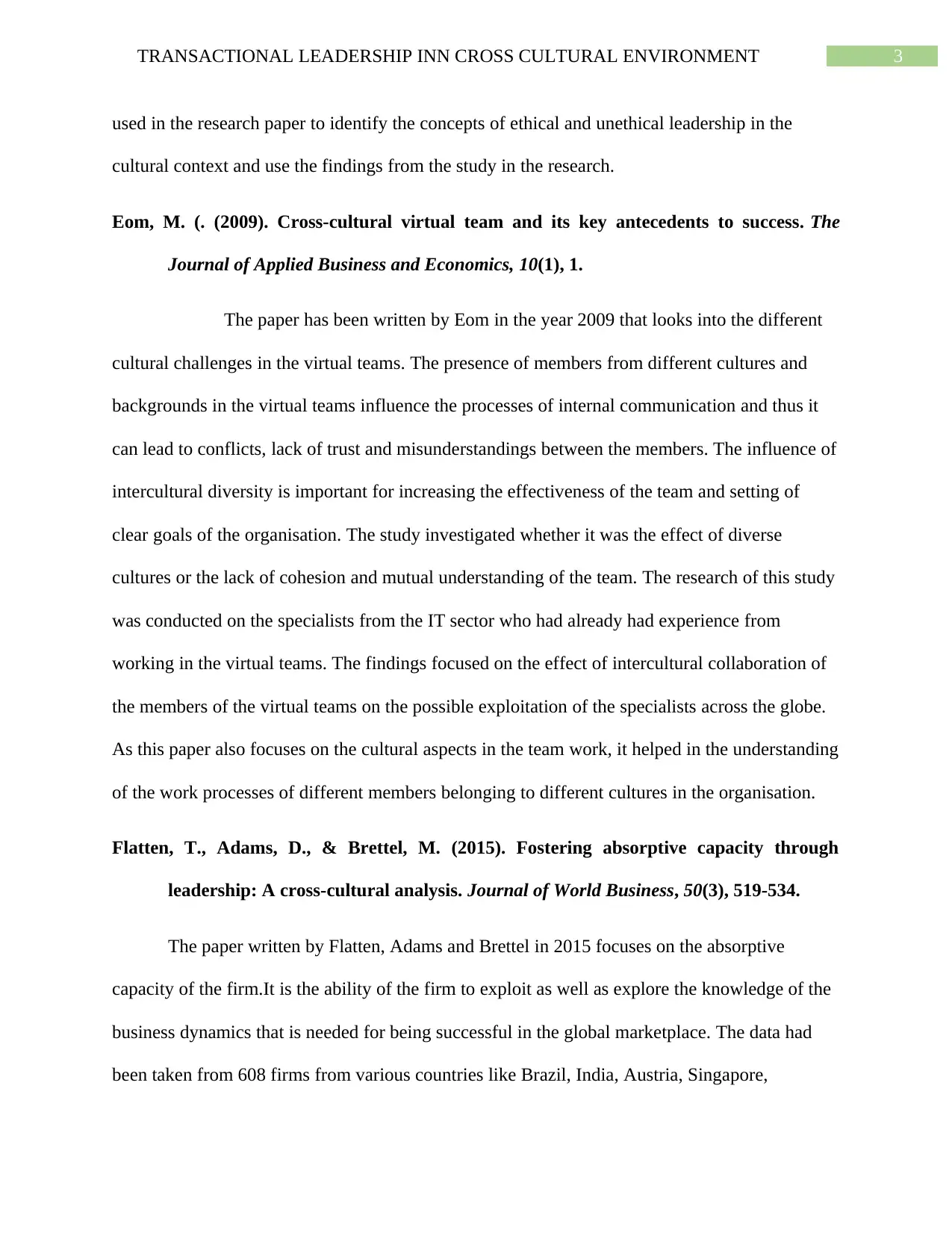
3TRANSACTIONAL LEADERSHIP INN CROSS CULTURAL ENVIRONMENT
used in the research paper to identify the concepts of ethical and unethical leadership in the
cultural context and use the findings from the study in the research.
Eom, M. (. (2009). Cross-cultural virtual team and its key antecedents to success. The
Journal of Applied Business and Economics, 10(1), 1.
The paper has been written by Eom in the year 2009 that looks into the different
cultural challenges in the virtual teams. The presence of members from different cultures and
backgrounds in the virtual teams influence the processes of internal communication and thus it
can lead to conflicts, lack of trust and misunderstandings between the members. The influence of
intercultural diversity is important for increasing the effectiveness of the team and setting of
clear goals of the organisation. The study investigated whether it was the effect of diverse
cultures or the lack of cohesion and mutual understanding of the team. The research of this study
was conducted on the specialists from the IT sector who had already had experience from
working in the virtual teams. The findings focused on the effect of intercultural collaboration of
the members of the virtual teams on the possible exploitation of the specialists across the globe.
As this paper also focuses on the cultural aspects in the team work, it helped in the understanding
of the work processes of different members belonging to different cultures in the organisation.
Flatten, T., Adams, D., & Brettel, M. (2015). Fostering absorptive capacity through
leadership: A cross-cultural analysis. Journal of World Business, 50(3), 519-534.
The paper written by Flatten, Adams and Brettel in 2015 focuses on the absorptive
capacity of the firm.It is the ability of the firm to exploit as well as explore the knowledge of the
business dynamics that is needed for being successful in the global marketplace. The data had
been taken from 608 firms from various countries like Brazil, India, Austria, Singapore,
used in the research paper to identify the concepts of ethical and unethical leadership in the
cultural context and use the findings from the study in the research.
Eom, M. (. (2009). Cross-cultural virtual team and its key antecedents to success. The
Journal of Applied Business and Economics, 10(1), 1.
The paper has been written by Eom in the year 2009 that looks into the different
cultural challenges in the virtual teams. The presence of members from different cultures and
backgrounds in the virtual teams influence the processes of internal communication and thus it
can lead to conflicts, lack of trust and misunderstandings between the members. The influence of
intercultural diversity is important for increasing the effectiveness of the team and setting of
clear goals of the organisation. The study investigated whether it was the effect of diverse
cultures or the lack of cohesion and mutual understanding of the team. The research of this study
was conducted on the specialists from the IT sector who had already had experience from
working in the virtual teams. The findings focused on the effect of intercultural collaboration of
the members of the virtual teams on the possible exploitation of the specialists across the globe.
As this paper also focuses on the cultural aspects in the team work, it helped in the understanding
of the work processes of different members belonging to different cultures in the organisation.
Flatten, T., Adams, D., & Brettel, M. (2015). Fostering absorptive capacity through
leadership: A cross-cultural analysis. Journal of World Business, 50(3), 519-534.
The paper written by Flatten, Adams and Brettel in 2015 focuses on the absorptive
capacity of the firm.It is the ability of the firm to exploit as well as explore the knowledge of the
business dynamics that is needed for being successful in the global marketplace. The data had
been taken from 608 firms from various countries like Brazil, India, Austria, Singapore,
Paraphrase This Document
Need a fresh take? Get an instant paraphrase of this document with our AI Paraphraser
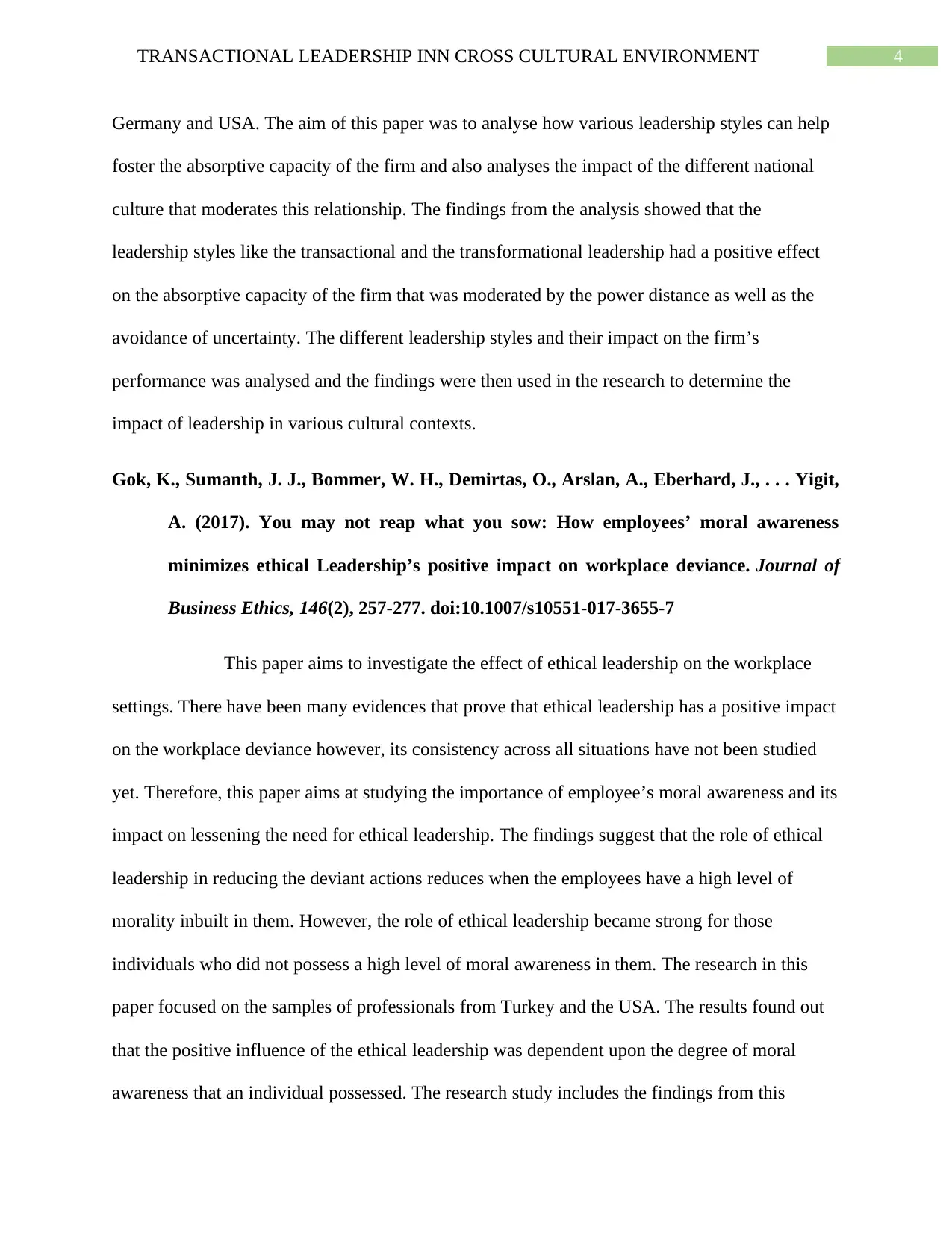
4TRANSACTIONAL LEADERSHIP INN CROSS CULTURAL ENVIRONMENT
Germany and USA. The aim of this paper was to analyse how various leadership styles can help
foster the absorptive capacity of the firm and also analyses the impact of the different national
culture that moderates this relationship. The findings from the analysis showed that the
leadership styles like the transactional and the transformational leadership had a positive effect
on the absorptive capacity of the firm that was moderated by the power distance as well as the
avoidance of uncertainty. The different leadership styles and their impact on the firm’s
performance was analysed and the findings were then used in the research to determine the
impact of leadership in various cultural contexts.
Gok, K., Sumanth, J. J., Bommer, W. H., Demirtas, O., Arslan, A., Eberhard, J., . . . Yigit,
A. (2017). You may not reap what you sow: How employees’ moral awareness
minimizes ethical Leadership’s positive impact on workplace deviance. Journal of
Business Ethics, 146(2), 257-277. doi:10.1007/s10551-017-3655-7
This paper aims to investigate the effect of ethical leadership on the workplace
settings. There have been many evidences that prove that ethical leadership has a positive impact
on the workplace deviance however, its consistency across all situations have not been studied
yet. Therefore, this paper aims at studying the importance of employee’s moral awareness and its
impact on lessening the need for ethical leadership. The findings suggest that the role of ethical
leadership in reducing the deviant actions reduces when the employees have a high level of
morality inbuilt in them. However, the role of ethical leadership became strong for those
individuals who did not possess a high level of moral awareness in them. The research in this
paper focused on the samples of professionals from Turkey and the USA. The results found out
that the positive influence of the ethical leadership was dependent upon the degree of moral
awareness that an individual possessed. The research study includes the findings from this
Germany and USA. The aim of this paper was to analyse how various leadership styles can help
foster the absorptive capacity of the firm and also analyses the impact of the different national
culture that moderates this relationship. The findings from the analysis showed that the
leadership styles like the transactional and the transformational leadership had a positive effect
on the absorptive capacity of the firm that was moderated by the power distance as well as the
avoidance of uncertainty. The different leadership styles and their impact on the firm’s
performance was analysed and the findings were then used in the research to determine the
impact of leadership in various cultural contexts.
Gok, K., Sumanth, J. J., Bommer, W. H., Demirtas, O., Arslan, A., Eberhard, J., . . . Yigit,
A. (2017). You may not reap what you sow: How employees’ moral awareness
minimizes ethical Leadership’s positive impact on workplace deviance. Journal of
Business Ethics, 146(2), 257-277. doi:10.1007/s10551-017-3655-7
This paper aims to investigate the effect of ethical leadership on the workplace
settings. There have been many evidences that prove that ethical leadership has a positive impact
on the workplace deviance however, its consistency across all situations have not been studied
yet. Therefore, this paper aims at studying the importance of employee’s moral awareness and its
impact on lessening the need for ethical leadership. The findings suggest that the role of ethical
leadership in reducing the deviant actions reduces when the employees have a high level of
morality inbuilt in them. However, the role of ethical leadership became strong for those
individuals who did not possess a high level of moral awareness in them. The research in this
paper focused on the samples of professionals from Turkey and the USA. The results found out
that the positive influence of the ethical leadership was dependent upon the degree of moral
awareness that an individual possessed. The research study includes the findings from this
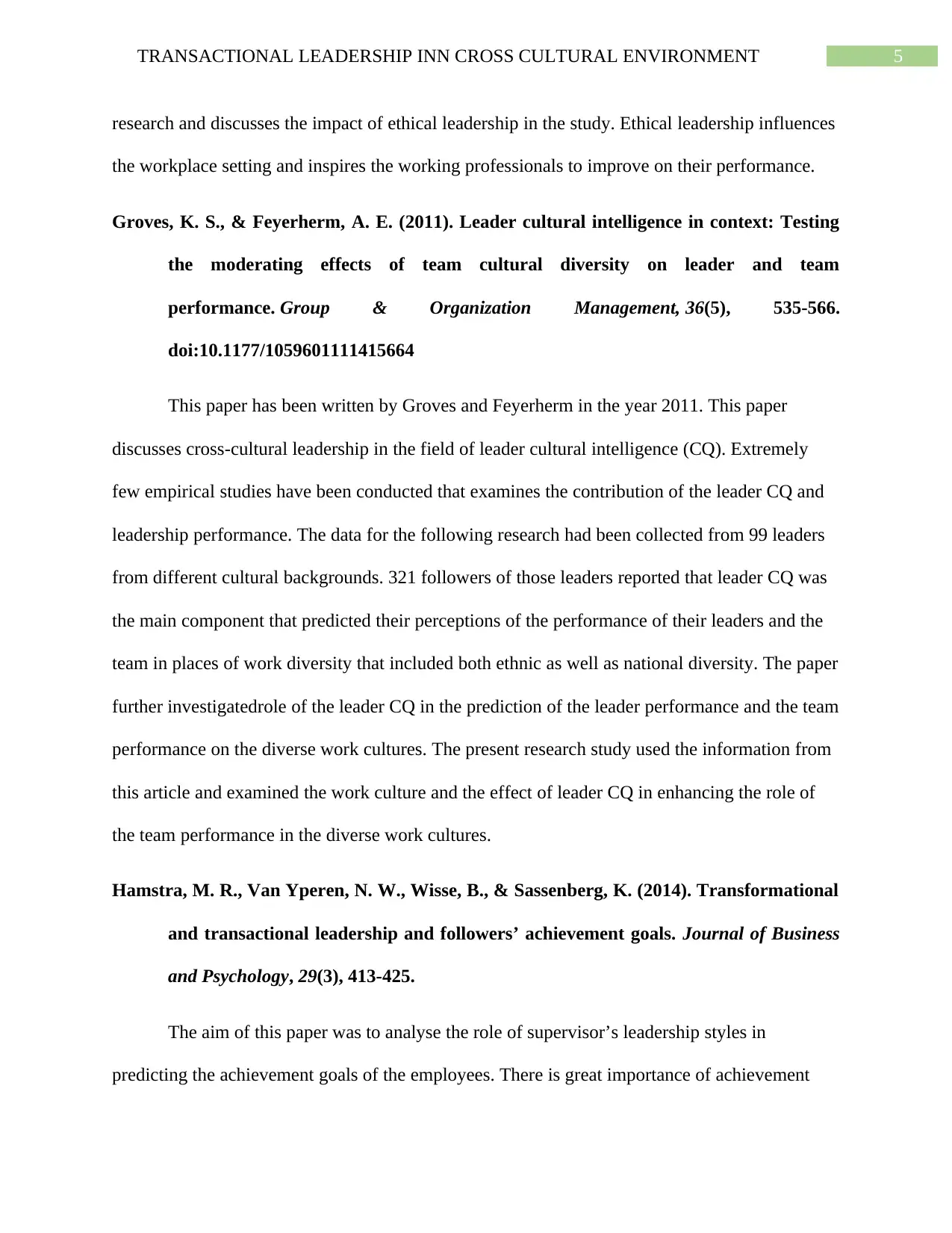
5TRANSACTIONAL LEADERSHIP INN CROSS CULTURAL ENVIRONMENT
research and discusses the impact of ethical leadership in the study. Ethical leadership influences
the workplace setting and inspires the working professionals to improve on their performance.
Groves, K. S., & Feyerherm, A. E. (2011). Leader cultural intelligence in context: Testing
the moderating effects of team cultural diversity on leader and team
performance. Group & Organization Management, 36(5), 535-566.
doi:10.1177/1059601111415664
This paper has been written by Groves and Feyerherm in the year 2011. This paper
discusses cross-cultural leadership in the field of leader cultural intelligence (CQ). Extremely
few empirical studies have been conducted that examines the contribution of the leader CQ and
leadership performance. The data for the following research had been collected from 99 leaders
from different cultural backgrounds. 321 followers of those leaders reported that leader CQ was
the main component that predicted their perceptions of the performance of their leaders and the
team in places of work diversity that included both ethnic as well as national diversity. The paper
further investigatedrole of the leader CQ in the prediction of the leader performance and the team
performance on the diverse work cultures. The present research study used the information from
this article and examined the work culture and the effect of leader CQ in enhancing the role of
the team performance in the diverse work cultures.
Hamstra, M. R., Van Yperen, N. W., Wisse, B., & Sassenberg, K. (2014). Transformational
and transactional leadership and followers’ achievement goals. Journal of Business
and Psychology, 29(3), 413-425.
The aim of this paper was to analyse the role of supervisor’s leadership styles in
predicting the achievement goals of the employees. There is great importance of achievement
research and discusses the impact of ethical leadership in the study. Ethical leadership influences
the workplace setting and inspires the working professionals to improve on their performance.
Groves, K. S., & Feyerherm, A. E. (2011). Leader cultural intelligence in context: Testing
the moderating effects of team cultural diversity on leader and team
performance. Group & Organization Management, 36(5), 535-566.
doi:10.1177/1059601111415664
This paper has been written by Groves and Feyerherm in the year 2011. This paper
discusses cross-cultural leadership in the field of leader cultural intelligence (CQ). Extremely
few empirical studies have been conducted that examines the contribution of the leader CQ and
leadership performance. The data for the following research had been collected from 99 leaders
from different cultural backgrounds. 321 followers of those leaders reported that leader CQ was
the main component that predicted their perceptions of the performance of their leaders and the
team in places of work diversity that included both ethnic as well as national diversity. The paper
further investigatedrole of the leader CQ in the prediction of the leader performance and the team
performance on the diverse work cultures. The present research study used the information from
this article and examined the work culture and the effect of leader CQ in enhancing the role of
the team performance in the diverse work cultures.
Hamstra, M. R., Van Yperen, N. W., Wisse, B., & Sassenberg, K. (2014). Transformational
and transactional leadership and followers’ achievement goals. Journal of Business
and Psychology, 29(3), 413-425.
The aim of this paper was to analyse the role of supervisor’s leadership styles in
predicting the achievement goals of the employees. There is great importance of achievement
⊘ This is a preview!⊘
Do you want full access?
Subscribe today to unlock all pages.

Trusted by 1+ million students worldwide
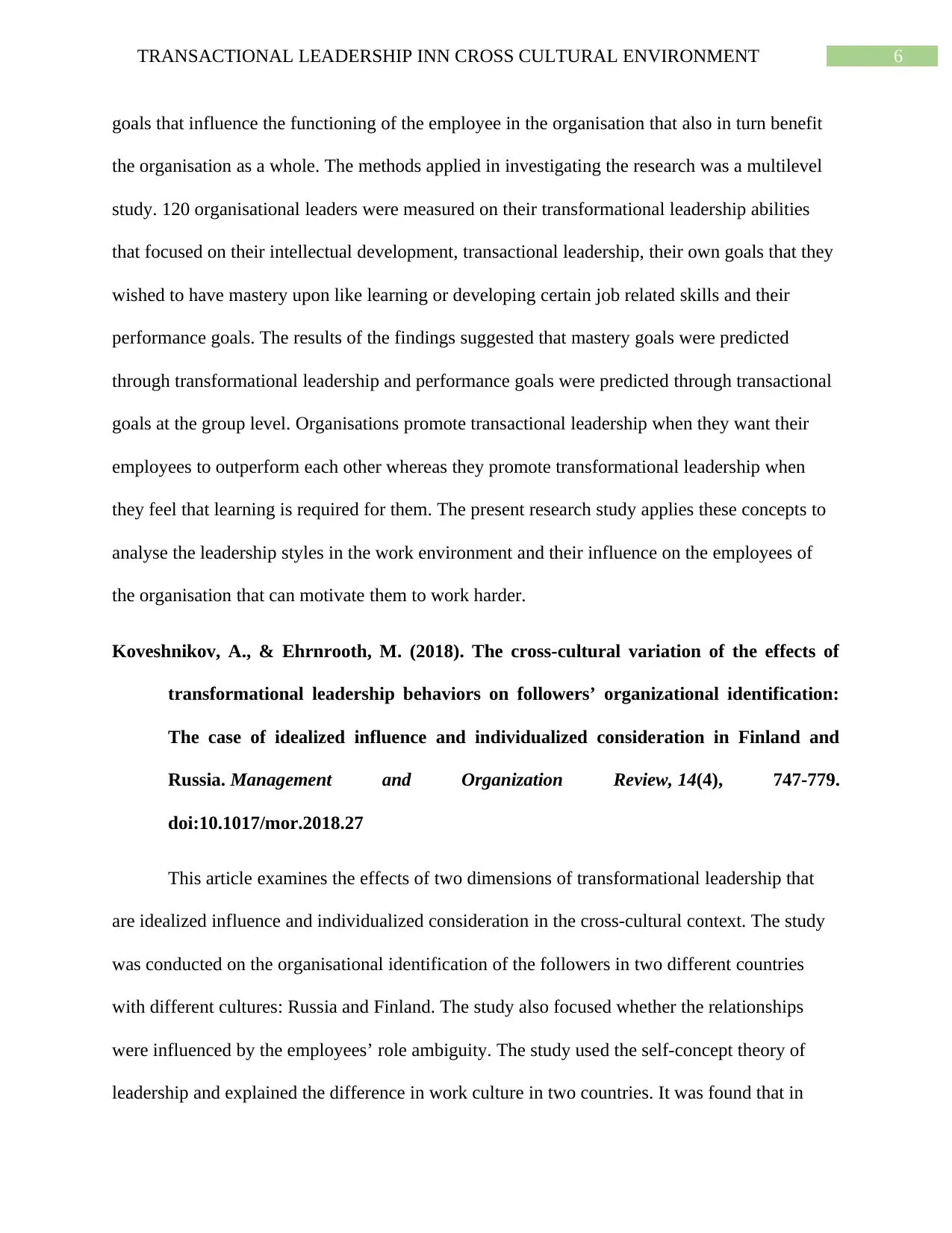
6TRANSACTIONAL LEADERSHIP INN CROSS CULTURAL ENVIRONMENT
goals that influence the functioning of the employee in the organisation that also in turn benefit
the organisation as a whole. The methods applied in investigating the research was a multilevel
study. 120 organisational leaders were measured on their transformational leadership abilities
that focused on their intellectual development, transactional leadership, their own goals that they
wished to have mastery upon like learning or developing certain job related skills and their
performance goals. The results of the findings suggested that mastery goals were predicted
through transformational leadership and performance goals were predicted through transactional
goals at the group level. Organisations promote transactional leadership when they want their
employees to outperform each other whereas they promote transformational leadership when
they feel that learning is required for them. The present research study applies these concepts to
analyse the leadership styles in the work environment and their influence on the employees of
the organisation that can motivate them to work harder.
Koveshnikov, A., & Ehrnrooth, M. (2018). The cross-cultural variation of the effects of
transformational leadership behaviors on followers’ organizational identification:
The case of idealized influence and individualized consideration in Finland and
Russia. Management and Organization Review, 14(4), 747-779.
doi:10.1017/mor.2018.27
This article examines the effects of two dimensions of transformational leadership that
are idealized influence and individualized consideration in the cross-cultural context. The study
was conducted on the organisational identification of the followers in two different countries
with different cultures: Russia and Finland. The study also focused whether the relationships
were influenced by the employees’ role ambiguity. The study used the self-concept theory of
leadership and explained the difference in work culture in two countries. It was found that in
goals that influence the functioning of the employee in the organisation that also in turn benefit
the organisation as a whole. The methods applied in investigating the research was a multilevel
study. 120 organisational leaders were measured on their transformational leadership abilities
that focused on their intellectual development, transactional leadership, their own goals that they
wished to have mastery upon like learning or developing certain job related skills and their
performance goals. The results of the findings suggested that mastery goals were predicted
through transformational leadership and performance goals were predicted through transactional
goals at the group level. Organisations promote transactional leadership when they want their
employees to outperform each other whereas they promote transformational leadership when
they feel that learning is required for them. The present research study applies these concepts to
analyse the leadership styles in the work environment and their influence on the employees of
the organisation that can motivate them to work harder.
Koveshnikov, A., & Ehrnrooth, M. (2018). The cross-cultural variation of the effects of
transformational leadership behaviors on followers’ organizational identification:
The case of idealized influence and individualized consideration in Finland and
Russia. Management and Organization Review, 14(4), 747-779.
doi:10.1017/mor.2018.27
This article examines the effects of two dimensions of transformational leadership that
are idealized influence and individualized consideration in the cross-cultural context. The study
was conducted on the organisational identification of the followers in two different countries
with different cultures: Russia and Finland. The study also focused whether the relationships
were influenced by the employees’ role ambiguity. The study used the self-concept theory of
leadership and explained the difference in work culture in two countries. It was found that in
Paraphrase This Document
Need a fresh take? Get an instant paraphrase of this document with our AI Paraphraser
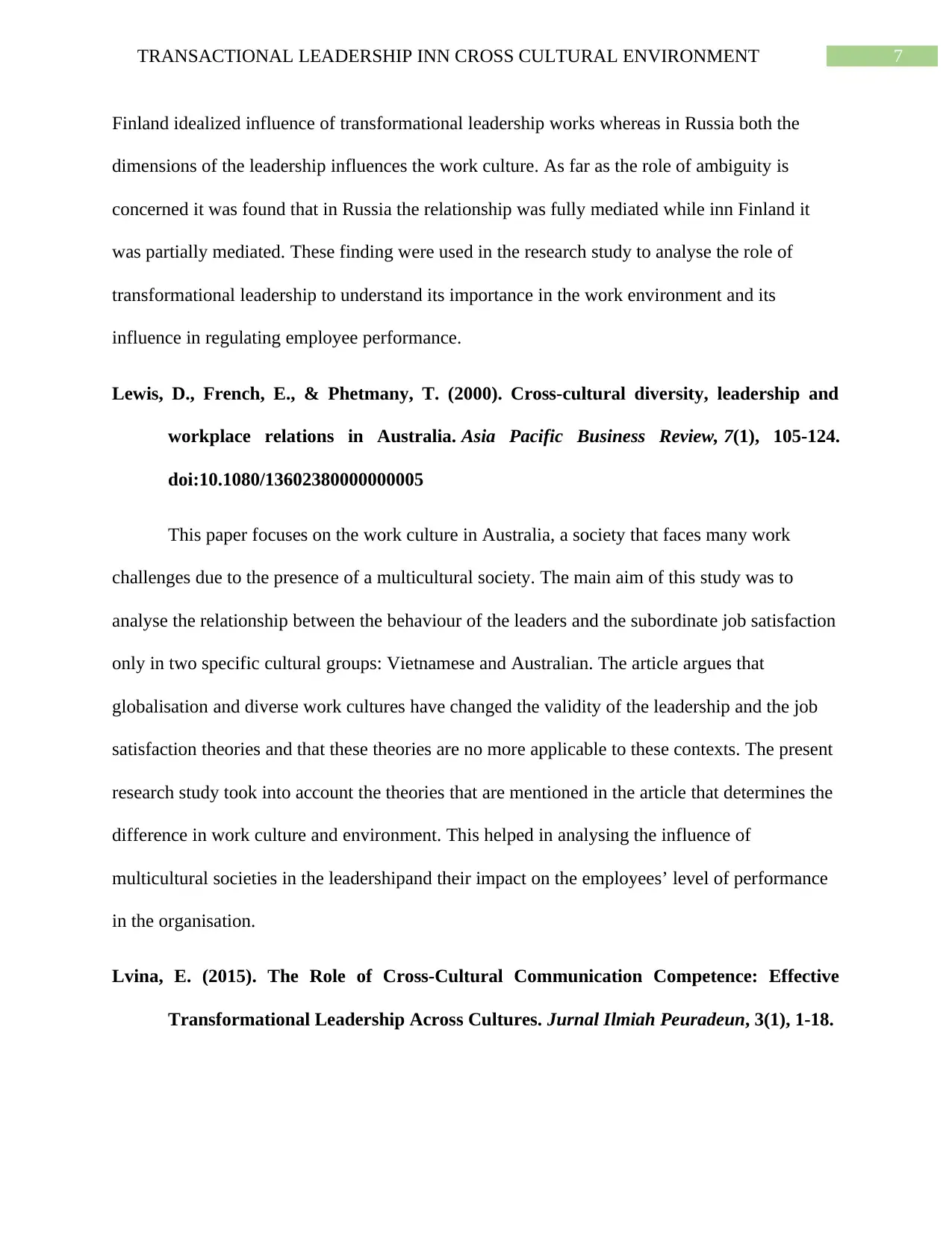
7TRANSACTIONAL LEADERSHIP INN CROSS CULTURAL ENVIRONMENT
Finland idealized influence of transformational leadership works whereas in Russia both the
dimensions of the leadership influences the work culture. As far as the role of ambiguity is
concerned it was found that in Russia the relationship was fully mediated while inn Finland it
was partially mediated. These finding were used in the research study to analyse the role of
transformational leadership to understand its importance in the work environment and its
influence in regulating employee performance.
Lewis, D., French, E., & Phetmany, T. (2000). Cross-cultural diversity, leadership and
workplace relations in Australia. Asia Pacific Business Review, 7(1), 105-124.
doi:10.1080/13602380000000005
This paper focuses on the work culture in Australia, a society that faces many work
challenges due to the presence of a multicultural society. The main aim of this study was to
analyse the relationship between the behaviour of the leaders and the subordinate job satisfaction
only in two specific cultural groups: Vietnamese and Australian. The article argues that
globalisation and diverse work cultures have changed the validity of the leadership and the job
satisfaction theories and that these theories are no more applicable to these contexts. The present
research study took into account the theories that are mentioned in the article that determines the
difference in work culture and environment. This helped in analysing the influence of
multicultural societies in the leadershipand their impact on the employees’ level of performance
in the organisation.
Lvina, E. (2015). The Role of Cross-Cultural Communication Competence: Effective
Transformational Leadership Across Cultures. Jurnal Ilmiah Peuradeun, 3(1), 1-18.
Finland idealized influence of transformational leadership works whereas in Russia both the
dimensions of the leadership influences the work culture. As far as the role of ambiguity is
concerned it was found that in Russia the relationship was fully mediated while inn Finland it
was partially mediated. These finding were used in the research study to analyse the role of
transformational leadership to understand its importance in the work environment and its
influence in regulating employee performance.
Lewis, D., French, E., & Phetmany, T. (2000). Cross-cultural diversity, leadership and
workplace relations in Australia. Asia Pacific Business Review, 7(1), 105-124.
doi:10.1080/13602380000000005
This paper focuses on the work culture in Australia, a society that faces many work
challenges due to the presence of a multicultural society. The main aim of this study was to
analyse the relationship between the behaviour of the leaders and the subordinate job satisfaction
only in two specific cultural groups: Vietnamese and Australian. The article argues that
globalisation and diverse work cultures have changed the validity of the leadership and the job
satisfaction theories and that these theories are no more applicable to these contexts. The present
research study took into account the theories that are mentioned in the article that determines the
difference in work culture and environment. This helped in analysing the influence of
multicultural societies in the leadershipand their impact on the employees’ level of performance
in the organisation.
Lvina, E. (2015). The Role of Cross-Cultural Communication Competence: Effective
Transformational Leadership Across Cultures. Jurnal Ilmiah Peuradeun, 3(1), 1-18.
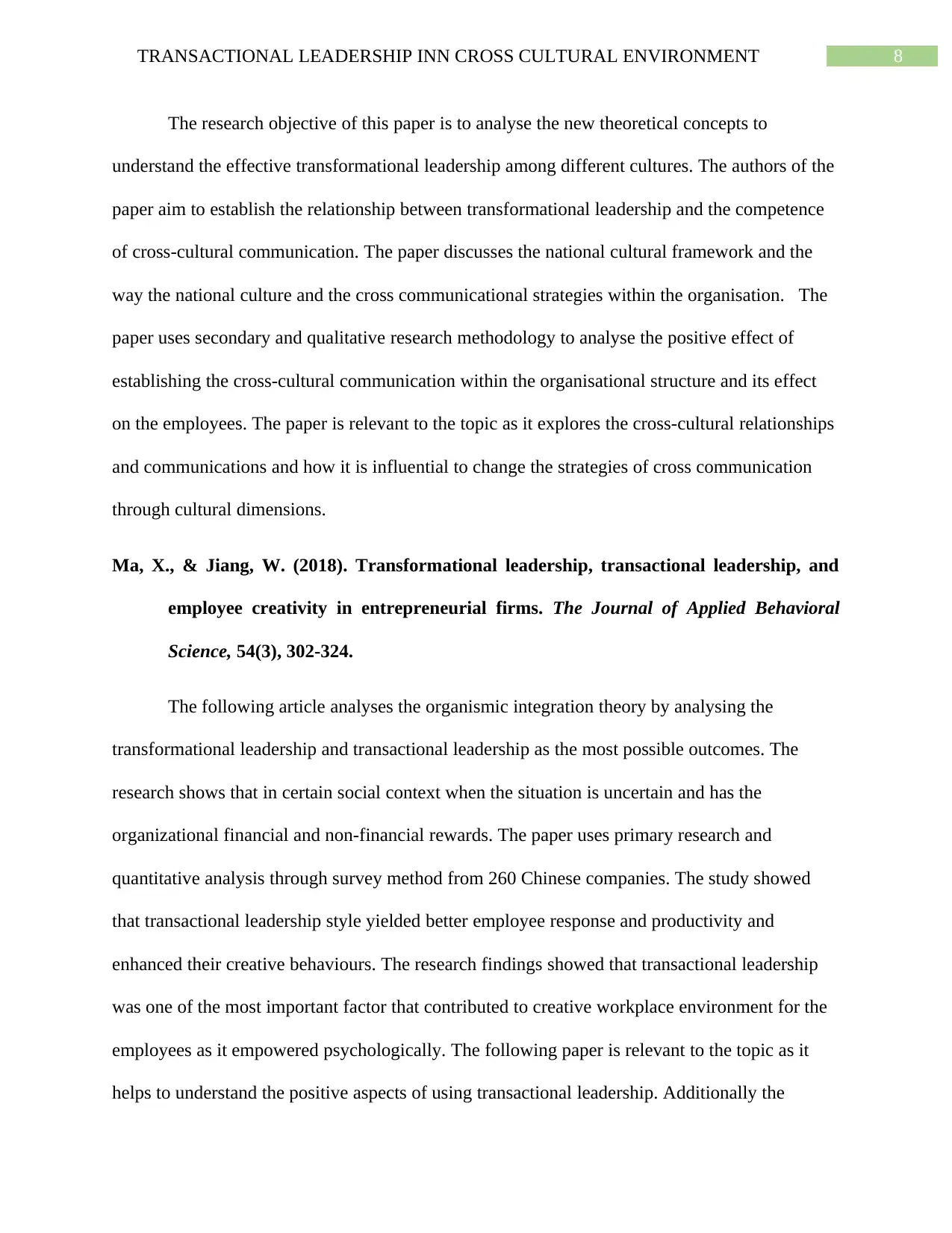
8TRANSACTIONAL LEADERSHIP INN CROSS CULTURAL ENVIRONMENT
The research objective of this paper is to analyse the new theoretical concepts to
understand the effective transformational leadership among different cultures. The authors of the
paper aim to establish the relationship between transformational leadership and the competence
of cross-cultural communication. The paper discusses the national cultural framework and the
way the national culture and the cross communicational strategies within the organisation. The
paper uses secondary and qualitative research methodology to analyse the positive effect of
establishing the cross-cultural communication within the organisational structure and its effect
on the employees. The paper is relevant to the topic as it explores the cross-cultural relationships
and communications and how it is influential to change the strategies of cross communication
through cultural dimensions.
Ma, X., & Jiang, W. (2018). Transformational leadership, transactional leadership, and
employee creativity in entrepreneurial firms. The Journal of Applied Behavioral
Science, 54(3), 302-324.
The following article analyses the organismic integration theory by analysing the
transformational leadership and transactional leadership as the most possible outcomes. The
research shows that in certain social context when the situation is uncertain and has the
organizational financial and non-financial rewards. The paper uses primary research and
quantitative analysis through survey method from 260 Chinese companies. The study showed
that transactional leadership style yielded better employee response and productivity and
enhanced their creative behaviours. The research findings showed that transactional leadership
was one of the most important factor that contributed to creative workplace environment for the
employees as it empowered psychologically. The following paper is relevant to the topic as it
helps to understand the positive aspects of using transactional leadership. Additionally the
The research objective of this paper is to analyse the new theoretical concepts to
understand the effective transformational leadership among different cultures. The authors of the
paper aim to establish the relationship between transformational leadership and the competence
of cross-cultural communication. The paper discusses the national cultural framework and the
way the national culture and the cross communicational strategies within the organisation. The
paper uses secondary and qualitative research methodology to analyse the positive effect of
establishing the cross-cultural communication within the organisational structure and its effect
on the employees. The paper is relevant to the topic as it explores the cross-cultural relationships
and communications and how it is influential to change the strategies of cross communication
through cultural dimensions.
Ma, X., & Jiang, W. (2018). Transformational leadership, transactional leadership, and
employee creativity in entrepreneurial firms. The Journal of Applied Behavioral
Science, 54(3), 302-324.
The following article analyses the organismic integration theory by analysing the
transformational leadership and transactional leadership as the most possible outcomes. The
research shows that in certain social context when the situation is uncertain and has the
organizational financial and non-financial rewards. The paper uses primary research and
quantitative analysis through survey method from 260 Chinese companies. The study showed
that transactional leadership style yielded better employee response and productivity and
enhanced their creative behaviours. The research findings showed that transactional leadership
was one of the most important factor that contributed to creative workplace environment for the
employees as it empowered psychologically. The following paper is relevant to the topic as it
helps to understand the positive aspects of using transactional leadership. Additionally the
⊘ This is a preview!⊘
Do you want full access?
Subscribe today to unlock all pages.

Trusted by 1+ million students worldwide
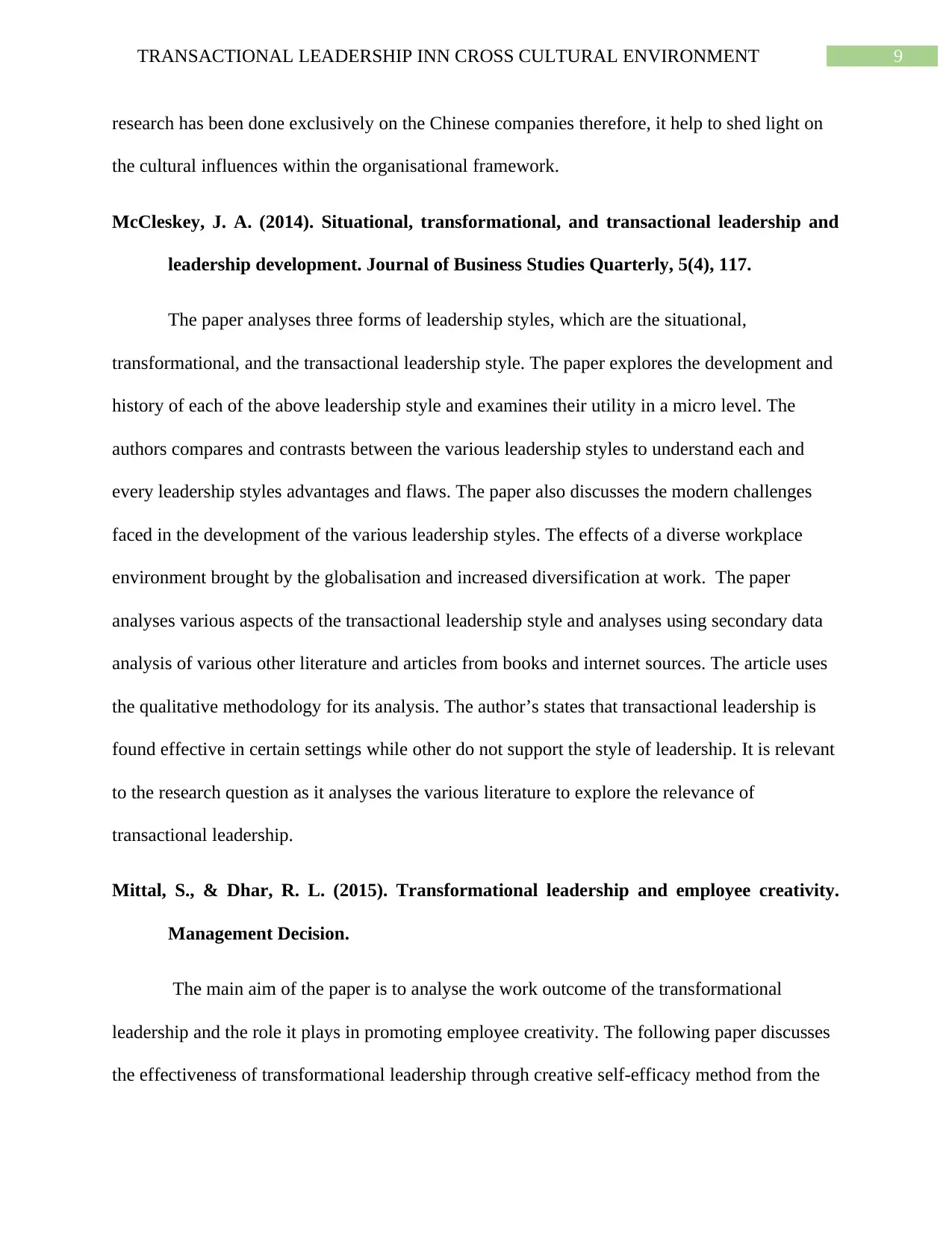
9TRANSACTIONAL LEADERSHIP INN CROSS CULTURAL ENVIRONMENT
research has been done exclusively on the Chinese companies therefore, it help to shed light on
the cultural influences within the organisational framework.
McCleskey, J. A. (2014). Situational, transformational, and transactional leadership and
leadership development. Journal of Business Studies Quarterly, 5(4), 117.
The paper analyses three forms of leadership styles, which are the situational,
transformational, and the transactional leadership style. The paper explores the development and
history of each of the above leadership style and examines their utility in a micro level. The
authors compares and contrasts between the various leadership styles to understand each and
every leadership styles advantages and flaws. The paper also discusses the modern challenges
faced in the development of the various leadership styles. The effects of a diverse workplace
environment brought by the globalisation and increased diversification at work. The paper
analyses various aspects of the transactional leadership style and analyses using secondary data
analysis of various other literature and articles from books and internet sources. The article uses
the qualitative methodology for its analysis. The author’s states that transactional leadership is
found effective in certain settings while other do not support the style of leadership. It is relevant
to the research question as it analyses the various literature to explore the relevance of
transactional leadership.
Mittal, S., & Dhar, R. L. (2015). Transformational leadership and employee creativity.
Management Decision.
The main aim of the paper is to analyse the work outcome of the transformational
leadership and the role it plays in promoting employee creativity. The following paper discusses
the effectiveness of transformational leadership through creative self-efficacy method from the
research has been done exclusively on the Chinese companies therefore, it help to shed light on
the cultural influences within the organisational framework.
McCleskey, J. A. (2014). Situational, transformational, and transactional leadership and
leadership development. Journal of Business Studies Quarterly, 5(4), 117.
The paper analyses three forms of leadership styles, which are the situational,
transformational, and the transactional leadership style. The paper explores the development and
history of each of the above leadership style and examines their utility in a micro level. The
authors compares and contrasts between the various leadership styles to understand each and
every leadership styles advantages and flaws. The paper also discusses the modern challenges
faced in the development of the various leadership styles. The effects of a diverse workplace
environment brought by the globalisation and increased diversification at work. The paper
analyses various aspects of the transactional leadership style and analyses using secondary data
analysis of various other literature and articles from books and internet sources. The article uses
the qualitative methodology for its analysis. The author’s states that transactional leadership is
found effective in certain settings while other do not support the style of leadership. It is relevant
to the research question as it analyses the various literature to explore the relevance of
transactional leadership.
Mittal, S., & Dhar, R. L. (2015). Transformational leadership and employee creativity.
Management Decision.
The main aim of the paper is to analyse the work outcome of the transformational
leadership and the role it plays in promoting employee creativity. The following paper discusses
the effectiveness of transformational leadership through creative self-efficacy method from the
Paraphrase This Document
Need a fresh take? Get an instant paraphrase of this document with our AI Paraphraser
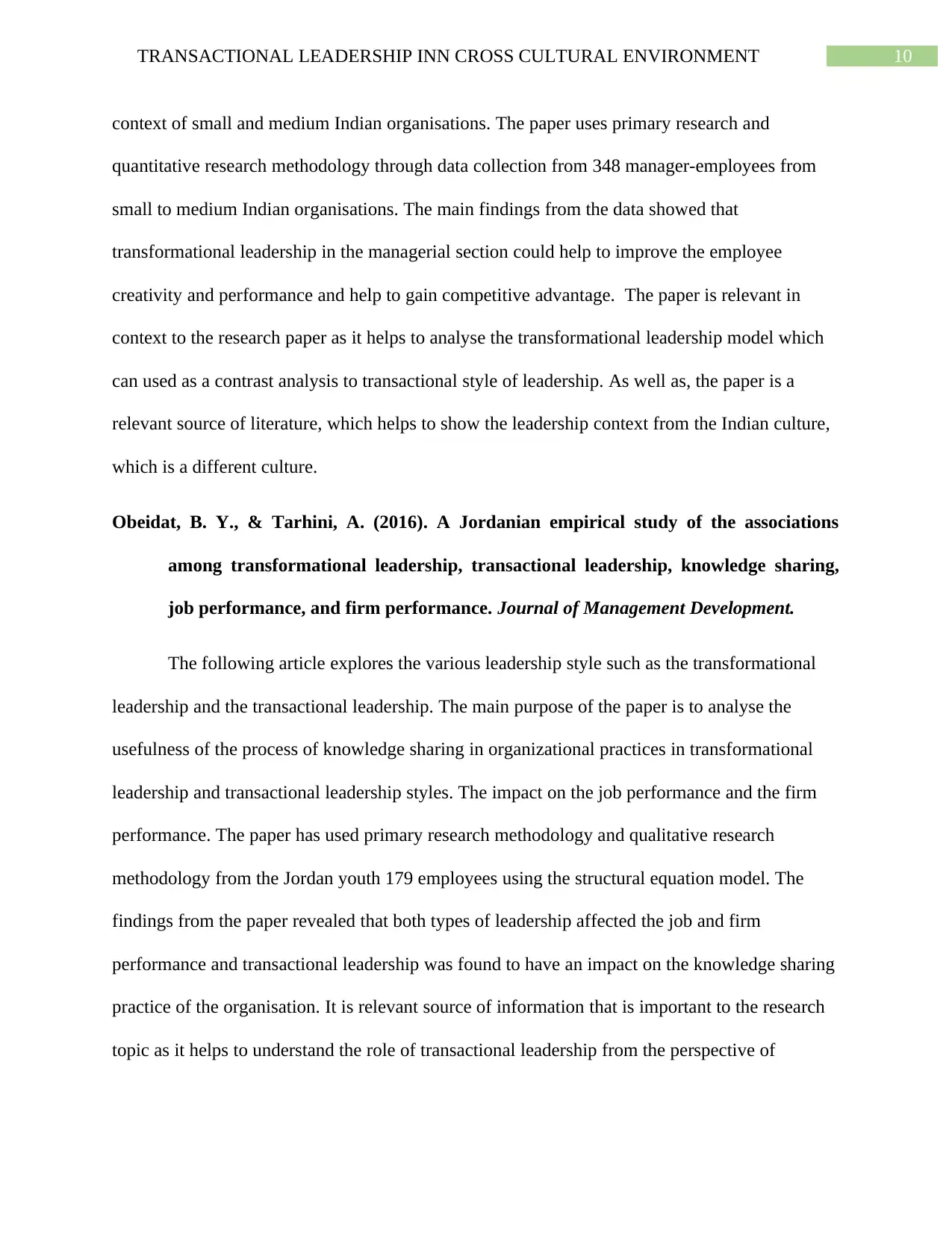
10TRANSACTIONAL LEADERSHIP INN CROSS CULTURAL ENVIRONMENT
context of small and medium Indian organisations. The paper uses primary research and
quantitative research methodology through data collection from 348 manager-employees from
small to medium Indian organisations. The main findings from the data showed that
transformational leadership in the managerial section could help to improve the employee
creativity and performance and help to gain competitive advantage. The paper is relevant in
context to the research paper as it helps to analyse the transformational leadership model which
can used as a contrast analysis to transactional style of leadership. As well as, the paper is a
relevant source of literature, which helps to show the leadership context from the Indian culture,
which is a different culture.
Obeidat, B. Y., & Tarhini, A. (2016). A Jordanian empirical study of the associations
among transformational leadership, transactional leadership, knowledge sharing,
job performance, and firm performance. Journal of Management Development.
The following article explores the various leadership style such as the transformational
leadership and the transactional leadership. The main purpose of the paper is to analyse the
usefulness of the process of knowledge sharing in organizational practices in transformational
leadership and transactional leadership styles. The impact on the job performance and the firm
performance. The paper has used primary research methodology and qualitative research
methodology from the Jordan youth 179 employees using the structural equation model. The
findings from the paper revealed that both types of leadership affected the job and firm
performance and transactional leadership was found to have an impact on the knowledge sharing
practice of the organisation. It is relevant source of information that is important to the research
topic as it helps to understand the role of transactional leadership from the perspective of
context of small and medium Indian organisations. The paper uses primary research and
quantitative research methodology through data collection from 348 manager-employees from
small to medium Indian organisations. The main findings from the data showed that
transformational leadership in the managerial section could help to improve the employee
creativity and performance and help to gain competitive advantage. The paper is relevant in
context to the research paper as it helps to analyse the transformational leadership model which
can used as a contrast analysis to transactional style of leadership. As well as, the paper is a
relevant source of literature, which helps to show the leadership context from the Indian culture,
which is a different culture.
Obeidat, B. Y., & Tarhini, A. (2016). A Jordanian empirical study of the associations
among transformational leadership, transactional leadership, knowledge sharing,
job performance, and firm performance. Journal of Management Development.
The following article explores the various leadership style such as the transformational
leadership and the transactional leadership. The main purpose of the paper is to analyse the
usefulness of the process of knowledge sharing in organizational practices in transformational
leadership and transactional leadership styles. The impact on the job performance and the firm
performance. The paper has used primary research methodology and qualitative research
methodology from the Jordan youth 179 employees using the structural equation model. The
findings from the paper revealed that both types of leadership affected the job and firm
performance and transactional leadership was found to have an impact on the knowledge sharing
practice of the organisation. It is relevant source of information that is important to the research
topic as it helps to understand the role of transactional leadership from the perspective of
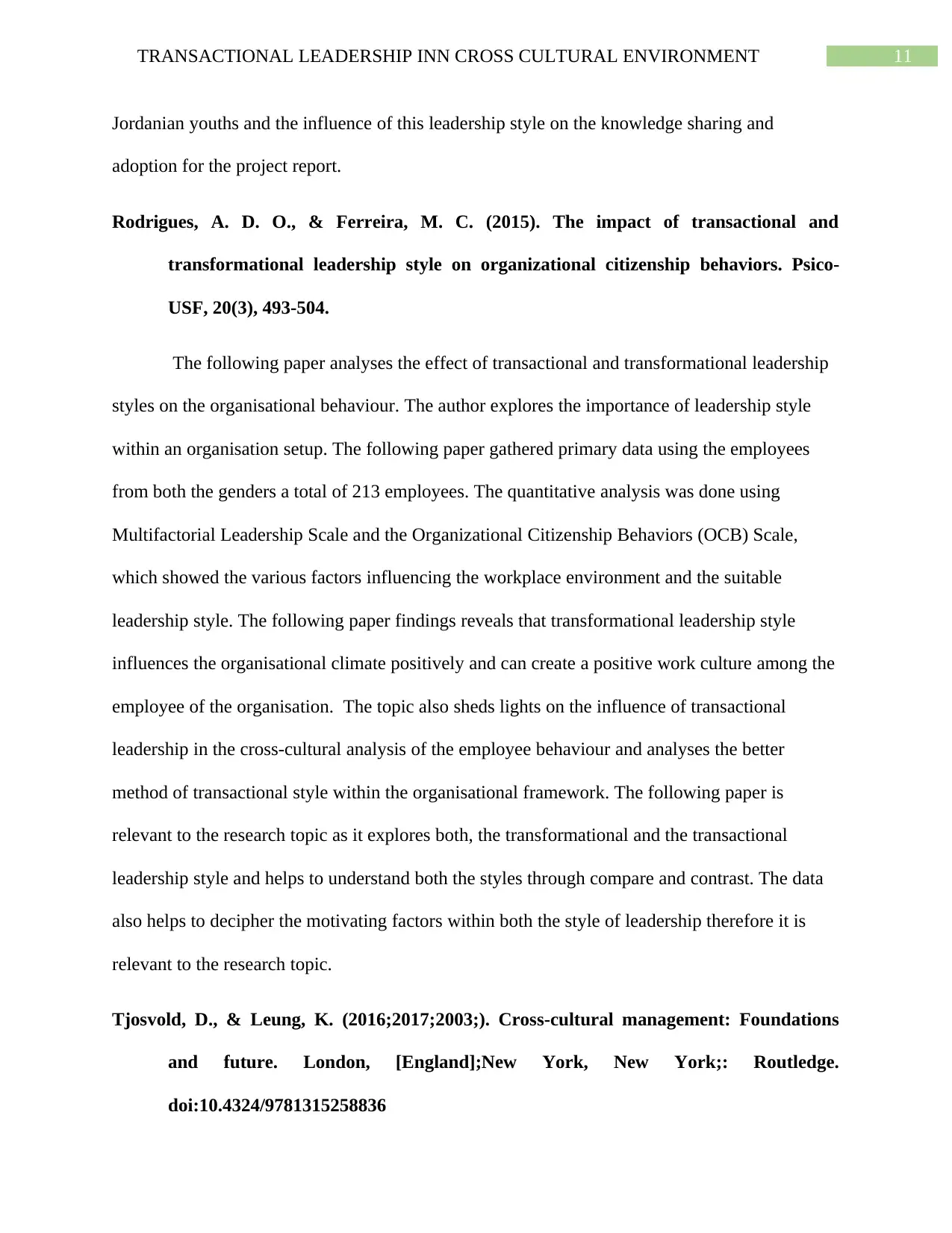
11TRANSACTIONAL LEADERSHIP INN CROSS CULTURAL ENVIRONMENT
Jordanian youths and the influence of this leadership style on the knowledge sharing and
adoption for the project report.
Rodrigues, A. D. O., & Ferreira, M. C. (2015). The impact of transactional and
transformational leadership style on organizational citizenship behaviors. Psico-
USF, 20(3), 493-504.
The following paper analyses the effect of transactional and transformational leadership
styles on the organisational behaviour. The author explores the importance of leadership style
within an organisation setup. The following paper gathered primary data using the employees
from both the genders a total of 213 employees. The quantitative analysis was done using
Multifactorial Leadership Scale and the Organizational Citizenship Behaviors (OCB) Scale,
which showed the various factors influencing the workplace environment and the suitable
leadership style. The following paper findings reveals that transformational leadership style
influences the organisational climate positively and can create a positive work culture among the
employee of the organisation. The topic also sheds lights on the influence of transactional
leadership in the cross-cultural analysis of the employee behaviour and analyses the better
method of transactional style within the organisational framework. The following paper is
relevant to the research topic as it explores both, the transformational and the transactional
leadership style and helps to understand both the styles through compare and contrast. The data
also helps to decipher the motivating factors within both the style of leadership therefore it is
relevant to the research topic.
Tjosvold, D., & Leung, K. (2016;2017;2003;). Cross-cultural management: Foundations
and future. London, [England];New York, New York;: Routledge.
doi:10.4324/9781315258836
Jordanian youths and the influence of this leadership style on the knowledge sharing and
adoption for the project report.
Rodrigues, A. D. O., & Ferreira, M. C. (2015). The impact of transactional and
transformational leadership style on organizational citizenship behaviors. Psico-
USF, 20(3), 493-504.
The following paper analyses the effect of transactional and transformational leadership
styles on the organisational behaviour. The author explores the importance of leadership style
within an organisation setup. The following paper gathered primary data using the employees
from both the genders a total of 213 employees. The quantitative analysis was done using
Multifactorial Leadership Scale and the Organizational Citizenship Behaviors (OCB) Scale,
which showed the various factors influencing the workplace environment and the suitable
leadership style. The following paper findings reveals that transformational leadership style
influences the organisational climate positively and can create a positive work culture among the
employee of the organisation. The topic also sheds lights on the influence of transactional
leadership in the cross-cultural analysis of the employee behaviour and analyses the better
method of transactional style within the organisational framework. The following paper is
relevant to the research topic as it explores both, the transformational and the transactional
leadership style and helps to understand both the styles through compare and contrast. The data
also helps to decipher the motivating factors within both the style of leadership therefore it is
relevant to the research topic.
Tjosvold, D., & Leung, K. (2016;2017;2003;). Cross-cultural management: Foundations
and future. London, [England];New York, New York;: Routledge.
doi:10.4324/9781315258836
⊘ This is a preview!⊘
Do you want full access?
Subscribe today to unlock all pages.

Trusted by 1+ million students worldwide
1 out of 19
Related Documents
Your All-in-One AI-Powered Toolkit for Academic Success.
+13062052269
info@desklib.com
Available 24*7 on WhatsApp / Email
![[object Object]](/_next/static/media/star-bottom.7253800d.svg)
Unlock your academic potential
Copyright © 2020–2025 A2Z Services. All Rights Reserved. Developed and managed by ZUCOL.





